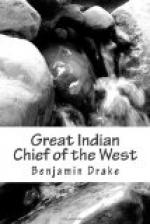Neapope, a chief of the British band, and second in command to Black Hawk, prior to the removal of the Indians to the west side of the Mississippi, had started on a visit to Malden, to consult their British Father in regard to the right to retain their lands on Rock river. He returned late in the fall, bringing word that in his opinion, the Americans could not take their lands, unless by purchase; and this purchase, it was contended by Black Hawk had never been made. Neapope on his way from Malden, called to see the Prophet, who assured him that early the ensuing spring, not only the British, but the Ottawas, Chippewas, Pottawatomies and Winnebagoes, would assist them to regain their village and the lands around it. Black Hawk believed, or affected to believe, this information, and began to make preparations to increase the number of his braves by recruiting from different villages. He sent a messenger to Keokuk, and to the Fox tribe, to inform them of the good news he had heard, and to ask their co-operation. Keokuk had too much sagacity to be imposed upon by tales of either British or Indian assistance, and sent word to Black Hawk that he was deceived and had better remain quiet. With a view of preventing further difficulty, he is said to have made application to the agent at St. Louis, that the chiefs of the Sacs and Foxes might be permitted to visit Washington city, to see the President, and if possible make a final adjustment of the matter in dispute. Black Hawk alledges he was anxious to make this visit to his Great Father, and had determined, to submit peaceably to his counsel, whatever it might be. But the arrangement for the visit, from some cause, was not perfected, and Black Hawk proceeded with his own plans. He established his head quarters at the point where Fort Madison formerly stood, on the west side of the Mississippi, and made another unsuccessful effort to draw into his support some of the braves under Keokuk. Having assembled his own party he began to ascend the Mississippi—the women and children in canoes with their provisions, camp equipage and property—his warriors armed and mounted on their horses. Below Rock island, they were met by the Prophet, who informed them that there was a great war chief then at Fort Armstrong, with a large body of soldiers. The Prophet stated that the agent and trader at Rock island, had attempted to dissuade him from joining Black Hawk, but he had refused to take their advice, because so long as they remained at peace, the Americans dare not molest them. Having reached the mouth of Rock river, in the early part of April 1832, the whole party rashly and in violation of the treaty of the previous year, crossed to the east side of the Mississippi, for the avowed purpose of ascending Rock river, to the territory of their friends, the Winnebagoes, and raising a crop of corn and beans with them. General Atkinson with a body of troops was then at Fort Armstrong, having been ordered by government to that point, for




